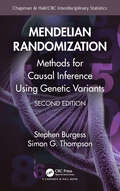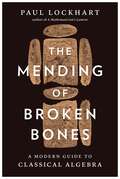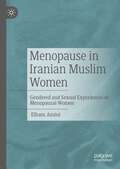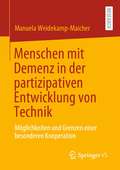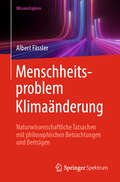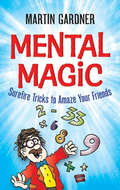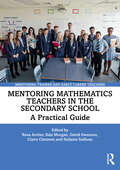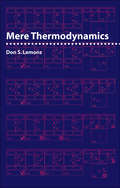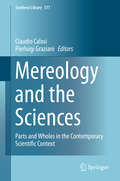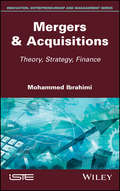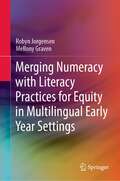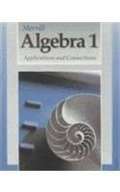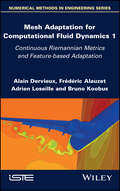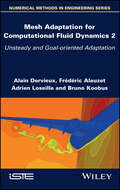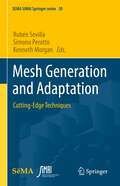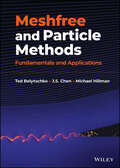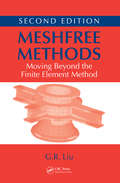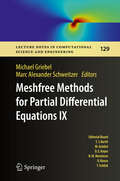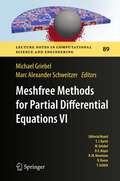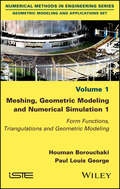- Table View
- List View
Mendelian Randomization: Methods for Causal Inference Using Genetic Variants (Chapman & Hall/CRC Interdisciplinary Statistics)
by Stephen Burgess Simon G. ThompsonMendelian Randomization: Methods For Causal Inference Using Genetic Variants provides thorough coverage of the methods and practical elements of Mendelian randomization analysis. It brings together diverse aspects of Mendelian randomization from the fields of epidemiology, statistics, genetics, and bioinformatics. Through multiple examples, the first part of the book introduces the reader to the concept of Mendelian randomization, showing how to perform simple Mendelian randomization investigations and interpret the results. The second part of the book addresses specific methodological issues relevant to the practice of Mendelian randomization, including robust methods, weak instruments, multivariable methods, and power calculations. The authors present the theoretical aspects of these issues in an easy-to-understand way by using non-technical language. The last part of the book examines the potential for Mendelian randomization in the future, exploring both methodological and applied developments. Features Offers first-hand, in-depth guidance on Mendelian randomization from leaders in the field Makes the diverse aspects of Mendelian randomization understandable to newcomers Illustrates technical details using data from applied analyses Discusses possible future directions for research involving Mendelian randomization Software code is provided in the relevant chapters and is also available at the supplementary website This book gives epidemiologists, statisticians, geneticists, and bioinformaticians the foundation to understand how to use genetic variants as instrumental variables in observational data. New in Second Edition: The second edition of the book has been substantially re-written to reduce the amount of technical content, and emphasize practical consequences of theoretical issues. Extensive material on the use of two-sample Mendelian randomization and publicly-available summarized data has been added. The book now includes several real-world examples that show how Mendelian randomization can be used to address questions of disease aetiology, target validation, and drug development
The Mending of Broken Bones: A Modern Guide to Classical Algebra
by Paul LockhartA joyful and intimate celebration of the beauty and creativity of algebra from one of the foremost math educators of our time.For many of us, algebra conjures up memories of dull classes spent wondering when we’d ever have to solve a system of equations or factor a polynomial. Indeed, most of the time, if we need to plan a budget or figure out how early to leave the house for work, common sense or a quick, seat-of-the-pants approximation is good enough.But as mathematician Paul Lockhart argues in The Mending of Broken Bones, once we stop thinking of algebra in terms of its practical applications, we can appreciate it for the beautiful and gratifying subject that it is. In his hands, algebra is the delicate craft of untangling numerical puzzles to reveal the hidden patterns and often surprising behaviors of the numbers themselves. As Lockhart traverses numerical systems, slips into and out of higher-dimensional space, and delights in the intimate connections between algebra and geometry, we come to see the discipline from his viewpoint: not as the mundane exercises of our school years, but instead as an art form whose beauty lies in its elegant simplicity.Written in Lockhart’s charming and conversational prose, The Mending of Broken Bones is an impassioned and deeply personal celebration of algebra that helps us experience the profound joys of mathematical discovery.
Menopause in Iranian Muslim Women: Gendered and Sexual Experiences of Menopausal Women
by Elham AminiThis book offers an original empirical study into the gendered and sexual experiences of Iranian Muslim women going through menopause. Using a biographical lifecourse lens, it explores the processes through which these experiences are shaped by hegemonic gender norms, as well as how these women express their agency. Centering the voices of Iranian Muslim women, this book links sexuality, ageing, and the body to the matter of menopause, conceived here as a gendered, embodied and lived phenomenon characterised both by cultural constraint and by individual reflexive body techniques. By considering gender and sexuality as vectors of power with internal politics, inequalities, and oppression alongside embodied practice, the author shows how the life course provides a trajectory of sex and sexuality that routes both in time, space, social and cultural context.
Menschen mit Demenz in der partizipativen Entwicklung von Technik: Möglichkeiten und Grenzen einer besonderen Kooperation
by Manuela Weidekamp-MaicherPartizipation an Forschung und Entwicklung gilt als Voraussetzung eines gelungenen Transfersvon Innovationen in die Gesellschaft. Dieser Zusammenhang besteht vor allem dann, wenninnovative Technik in den Mittelpunkt der Betrachtung rückt. Wie ist es jedoch um diePartizipation künftiger Nutzerinnen und Nutzer an der Erforschung neuer Technologienbestellt? Welche Möglichkeiten bestehen vor allem dann, wenn die zu entwickelnde Technikder Unterstützung vulnerabler Personengruppen dient? Menschen mit Demenz sind eine solcheZielgruppe, die vor dem Hintergrund des demografischen Wandels keinesfalls ignoriertwerden darf. Das Buch gibt einen Überblick über Chancen und Risiken, Möglichkeiten undGrenzen – vor allem jedoch über Besonderheiten – der Partizipation von Menschen mitDemenz an der Entwicklung von Technik und lädt dazu ein, deren Mitwirkung alsentscheidendes Element einer selbstbestimmten Lebensweltgestaltung zu betrachten und zuunterstützen.
Menschheitsproblem Klimaänderung: Naturwissenschaftliche Tatsachen mit philosophischen Betrachtungen und Beiträgen
by Albert FässlerDas vorliegende Buch analysiert den zukünftigen Temperaturverlauf der Erdoberfläche mithilfe eines naturwissenschaftlichen Modells und gibt eine Übersicht über die Ursachen und Auswirkungen des Klimawandels. Der Inhalt umfasst außerdem relevante Daten und Fakten zu den Themen Kohlenstoffbudget, Demographie, Gletscher, Permafrost, Artenvielfalt, Mobilität und Extremwetter. Die rasche globale Reduzierung des CO2-Anstiegs auf Netto-Null ist eine dringende Notwendigkeit, um nachfolgenden Generationen ein menschenwürdiges Leben zu ermöglichen. Die Industriestaaten tragen als Hauptverursacher eine moralische Verantwortung, die erwähnte Reduzierung zügig umzusetzen und die Entwicklungsländer in diesem Prozess zu unterstützen. Das Buch richtet sich auch an Personen mit wenig Bezug zur Mathematik.Die Produktfamilie WissensExpress bietet Ihnen Lehr- und Lernbücher in kompakter Form. Die Bücher liefern schnell und verständlich fundiertes Wissen.
Mental Magic: Surefire Tricks to Amaze Your Friends (Dover Children's Activity Books)
by Martin Gardner Jeff SinclairA barber in Chicago says he'd rather cut the hair of ten red-headed men than the hair of one brown-haired man. Can you guess why?Ask Professor Picanumba, a master of riddles who carries dozens of surefire tricks up his sleeve. He'll show you how to astonish your friends and family by predicting the answers to 88 word and number challenges. These tricks require only simple props--a deck of cards or a couple of pairs of dice, a calculator, and a pencil and paper. With or without an audience, these foolproof feats of mental magic offer hours of amusement. Solutions appear at the end, with 64 illustrations in between.Author Martin Gardner has written more than 70 books on subjects from science and math to poetry and religion. Well known for the mathematical games that appeared in Scientific American for decades and for his "Trick of the Month" column in Physics Teacher magazine, Gardner has had a lifelong passion for magic tricks and puzzles.
Mentoring Mathematics Teachers in the Secondary School: A Practical Guide (Mentoring Trainee and Early Career Teachers)
by Rosa Archer, Siân Morgan, David Swanson, Claire Clemmet and Stefanie SullivanThis practical workbook assists school-based mentors of mathematics teachers to develop their mentoring skills, offering mentors the essential guidance needed in order to effectively support trainee or newly qualified secondary mathematics teachers, as well as in their overall career development. Offering tried and tested strategies based on research and evidence, Mentoring Mathematics Teachers in the Secondary School covers the knowledge, skills and understanding every mentor needs and offers practical tools such as lesson plans and feedback sheets, observation sheets, case studies, sample dialogues and other learning activities and exercises. Together with analytical tools for self-evaluation, this book is a vital source of support and inspiration for all those involved in developing the next generation of outstanding mathematics teachers, whether in teacher training or as newly qualified or early-career teachers. Key topics explored include: Roles and responsibilities of mentors within mathematics education, and understanding yourself as a mentor The mentor–mentee relationship, and helping develop a beginning teacher’s identity Supporting specific aspects of beginning mathematics teachers’ knowledge, skills and understanding, including developing reflective practice, lesson planning and mathematical misconceptions Strategies for observation and analysis of lessons, marking, assessment and the use of data Mentoring for long-term career and teacher development Filled with the key tools needed for the mentor’s individual development, Mentoring Mathematics Teachers in the Secondary School offers an accessible and practical guide to mentoring trainee teachers and early-career teachers with ready-to-use strategies that support, inspire and elevate both mentors and teachers alike. This book also includes an online eResource offering downloadable resources and web-based training material.
Mere Thermodynamics
by Don S. LemonsPresenting classical thermodynamics as a concise and discrete whole, Mere Thermodynamics is a perfect tool for teaching a notoriously difficult subject.Accomplished teacher Don S. Lemons introduces the physical theory's concepts and methods and uses them to solve problems from a broad range of physics. He illustrates, at a gentle pace, not only the fundamentals of the subject but also advanced topics such as the relationship between the second law of thermodynamics and entropy. He highlights the intellectual structure and history of the discipline and explores the logical consequences of each of the famous three laws. Lemons explains and develops the first two laws and their corollaries, the methods and applications of thermodynamics, and the third law, as well as non-fluid variables, equilibrium and stability, and two-phase systems.The book features end-of-chapter practice problems, an appendix of worked problems, a glossary of terms, and an annotated bibliography.
Mereology and the Sciences: Parts and Wholes in the Contemporary Scientific Context (Synthese Library #371)
by Claudio Calosi Pierluigi GrazianiThis volume is the first systematic and thorough attempt to investigate the relation and the possible applications of mereology to contemporary science. It gathers contributions from leading scholars in the field and covers a wide range of scientific theories and practices such as physics, mathematics, chemistry, biology, computer science and engineering. Throughout the volume, a variety of foundational issues are investigated both from the formal and the empirical point of view.The first section looks at the topic as it applies to physics. The section addresses questions of persistence and composition within quantum and relativistic physics and concludes by scrutinizing the possibility to capture continuity of motion as described by our best physical theories within gunky space times.The second part tackles mathematics and shows how to provide a foundation for point-free geometry of space switching to fuzzy-logic. The relation between mereological sums and set-theoretic suprema is investigated and issues about different mereological perspectives such as classical and natural Mereology are thoroughly discussed.The third section in the volume looks at natural science. Several questions from biology, medicine and chemistry are investigated. From the perspective of biology, there is an attempt to provide axioms for inferring statements about part hood between two biological entities from statements about their spatial relation. From the perspective of chemistry, it is argued that classical mereological frameworks are not adequate to capture the practices of chemistry in that they consider neither temporal nor modal parameters.The final part introduces computer science and engineering. A new formal mereological framework in which an indeterminate relation of part hood is taken as a primitive notion is constructed and then applied to a wide variety of disciplines from robotics to knowledge engineering. A formal framework for discrete mereotopology and its applications is developed and finally, the importance of mereology for the relatively new science of domain engineering is also discussed.
Mergers & Acquisitions: Theory, Strategy, Finance
by Mohammed IbrahimiThis book deals with corporate mergers and acquisitions by analyzing the financial and strategic aspects. It starts with a chronological justification of the evolution of external growth operations and ends with case studies in order to put into practice the theoretical contribution of the previous titles. Through this book, we wish to detail the types of mergers and acquisitions, their modes, their motivations, their consequences and their performances. First of all, we propose a panoply of scientific research, methodological explanations and logical structuring to expose a subject of experience considered for a long time as a phenomenon in finance. Then, through a sample of 90 mergers or acquisitions, we analyze the effects of these transactions on French companies.
Merging Numeracy with Literacy Practices for Equity in Multilingual Early Year Settings
by Robyn Jorgensen Mellony GravenThis book draws on both in and out of school literacy practices with teachers and families to enhance the numeracy of early learners. It provides highly illustrative exemplars, targeted for learners up to approximately eight years of age whose home language differs from the language of instruction. It identifies the challenges faced by these learners and their families, and shares ways of building both literacy and numeracy skills for some of the vulnerable learners nationally and internationally.The book shares the outcomes and strategies for teaching mathematics to early years learners and highlights the importance of literacy practices for learners for whom the language of instruction is different from their home language. Readers will gain a practical sense of how to create contexts, classrooms and practices to scaffold these learners to build robust understandings of mathematics.
Merrill Algebra 1
by FosterDr. Miles Bennett discovers that his patients' strange behavior is due to an invasion of giant alien "pods," which are taking over the bodies of Santa Mira's citizens as they sleep.
Merrill Algebra 2 with Trigonometry: Applications and Connections
by Glencoe McGraw-Hill StaffAlgebra textbook
Mesh Adaptation for Computational Fluid Dynamics, Volume 1: Continuous Riemannian Metrics and Feature-based Adaptation
by Alain Dervieux Frederic Alauzet Adrien Loseille Bruno KoobusSimulation technology, and computational fluid dynamics (CFD) in particular, is essential in the search for solutions to the modern challenges faced by humanity. Revolutions in CFD over the last decade include the use of unstructured meshes, permitting the modeling of any 3D geometry. New frontiers point to mesh adaptation, allowing not only seamless meshing (for the engineer) but also simulation certification for safer products and risk prediction.Mesh Adaptation for Computational Dynamics 1 is the first of two volumes and introduces basic methods such as feature-based and multiscale adaptation for steady models. Also covered is the continuous Riemannian metrics formulation which models the optimally adapted mesh problem into a pure partial differential statement. A number of mesh adaptative methods are defined based on a particular feature of the simulation solution.This book will be useful to anybody interested in mesh adaptation pertaining to CFD, especially researchers, teachers and students.
Mesh Adaptation for Computational Fluid Dynamics, Volume 2: Unsteady and Goal-oriented Adaptation
by Alain Dervieux Frederic Alauzet Adrien Loseille Bruno KoobusSimulation technology, and computational fluid dynamics (CFD) in particular, is essential in the search for solutions to the modern challenges faced by humanity. Revolutions in CFD over the last decade include the use of unstructured meshes, permitting the modeling of any 3D geometry. New frontiers point to mesh adaptation, allowing not only seamless meshing (for the engineer) but also simulation certification for safer products and risk prediction.Mesh Adaptation for Computational Dynamics 2 is the second of two volumes and introduces topics including optimal control formulation, minimizing a goal function, and extending the steady algorithm to unsteady physics. Also covered are multi-rate strategies, steady inviscid flows in aeronautics and an extension to viscous flows.This book will be useful to anybody interested in mesh adaptation pertaining to CFD, especially researchers, teachers and students.
Mesh Generation and Adaptation: Cutting-Edge Techniques (SEMA SIMAI Springer Series #30)
by Rubén Sevilla Simona Perotto Kenneth MorganThe developments in mesh generation are usually driven by the needs of new applications and/or novel algorithms. The last decade has seen a renewed interest in mesh generation and adaptation by the computational engineering community, due to the challenges introduced by complex industrial problems.Another common challenge is the need to handle complex geometries. Nowadays, it is becoming obvious that geometry should be persistent throughout the whole simulation process. Several methodologies that can carry the geometric information throughout the simulation stage are available, but due to the novelty of these methods, the generation of suitable meshes for these techniques is still the main obstacle for the industrial uptake of this technology.This book will cover different aspects of mesh generation and adaptation, with particular emphasis on cutting-edge mesh generation techniques for advanced discretisation methods and complex geometries.
Meshfree and Particle Methods: Fundamentals and Applications
by Ted Belytschko J. S. Chen Michael HillmanMeshfree and Particle Methods Provides thorough coverage of essential concepts and state-of-the-art developments in the field Meshfree and Particle Methods is the first book of its kind to combine comprehensive, up-to-date information on the fundamental theories and applications of meshfree methods with systematic guidance on practical coding implementation. Broad in scope and content, this unique volume provides readers with the knowledge necessary to perform research and solve challenging problems in nearly all fields of science and engineering using meshfree computational techniques. The authors provide detailed descriptions of essential issues in meshfree methods, as well as specific techniques to address them, while discussing a wide range of subjects and use cases. Topics include approximations in meshfree methods, nonlinear meshfree methods, essential boundary condition enforcement, quadrature in meshfree methods, strong form collocation methods, and more. Throughout the book, topics are integrated with descriptions of computer implementation and an open-source code (with a dedicated chapter for users) to illustrate the connection between the formulations discussed in the text and their real-world implementation and application. This authoritative resource: Explains the fundamentals of meshfree methods, their constructions, and their unique capabilities as compared to traditional methods Features an overview of the open-source meshfree code RKPM2D, including code and numerical examples Describes all the variational concepts required to solve scientific and engineering problems using meshfree methods such as Nitsche’s method and the Lagrange multiplier method Includes comprehensive reviews of essential boundary condition enforcement, quadrature in meshfree methods, and nonlinear aspects of meshfree analysis Discusses other Galerkin meshfree methods, strong form meshfree methods, and their comparisons Meshfree and Particle Methods: Fundamentals and Applications is the perfect introduction to meshfree methods for upper-level students in advanced numerical analysis courses, and is an invaluable reference for professionals in mechanical, aerospace, civil, and structural engineering, and related fields, who want to understand and apply these concepts directly, or effectively use commercial and other production meshfree and particle codes in their work.
Meshfree Methods: Moving Beyond the Finite Element Method, Second Edition
by G.R. LiuUnderstand How to Use and Develop Meshfree TechniquesAn Update of a Groundbreaking WorkReflecting the significant advances made in the field since the publication of its predecessor, Meshfree Methods: Moving Beyond the Finite Element Method, Second Edition systematically covers the most widely used meshfree methods. With 70% new material, this edit
Meshfree Methods for Partial Differential Equations IX (Lecture Notes in Computational Science and Engineering #129)
by Michael Griebel Marc Alexander SchweitzerThis volume collects selected papers presented at the Ninth International Workshop on Meshfree Methods held in Bonn, Germany in September 2017. They address various aspects of this very active research field and cover topics from applied mathematics, physics and engineering.The numerical treatment of partial differential equations with meshfree discretization techniques has been a very active research area in recent years. While the fundamental theory of meshfree methods has been developed and considerable advances of the various methods have been made, many challenges in the mathematical analysis and practical implementation of meshfree methods remain.This symposium aims to promote collaboration among engineers, mathematicians, and computer scientists and industrial researchers to address the development, mathematical analysis, and application of meshfree and particle methods especially to multiscale phenomena. It continues the 2-year-cycled Workshops on Meshfree Methods for Partial Differential Equations.
Meshfree Methods for Partial Differential Equations VII
by Marc Alexander Schweitzer Michael GriebelMeshfree methods, particle methods, and generalized finite element methods have witnessed substantial development since the mid 1990s. The growing interest in these methods is due in part to the fact that they are extremely flexible numerical tools and can be interpreted in a number of ways. For instance, meshfree methods can be viewed as a natural extension of classical finite element and finite difference methods to scattered node configurations with no fixed connectivity. Furthermore, meshfree methods offer a number of advantageous features which are especially attractive when dealing with multiscale phenomena: a priori knowledge about particular local behavior of the solution can easily be introduced in the meshfree approximation space, and coarse-scale approximations can be seamlessly refined with fine-scale information. This volume collects selected papers presented at the Seventh International Workshop on Meshfree Methods, held in Bonn, Germany in September 2013. They address various aspects of this highly dynamic research field and cover topics from applied mathematics, physics and engineering.
Meshing, Geometric Modeling and Numerical Simulation 1: Form Functions, Triangulations and Geometric Modeling
by Houman Borouchaki Paul Louis GeorgeTriangulations, and more precisely meshes, are at the heart of many problems relating to a wide variety of scientific disciplines, and in particular numerical simulations of all kinds of physical phenomena. In numerical simulations, the functional spaces of approximation used to search for solutions are defined from meshes, and in this sense these meshes play a fundamental role. This strong link between the meshes and functional spaces leads us to consider advanced simulation methods in which the meshes are adapted to the behaviors of the underlying physical phenomena. This book presents the basic elements of this meshing vision.
Meshing, Geometric Modeling and Numerical Simulation 2: Metrics, Meshes and Mesh Adaptation
by Paul Louis George Houman Borouchaki Frederic Alauzet Patrick Laug Adrien Loseille Loic MarechalTriangulations, and more precisely meshes, are at the heart of many problems relating to a wide variety of scientific disciplines, and in particular numerical simulations of all kinds of physical phenomena. In numerical simulations, the functional spaces of approximation used to search for solutions are defined from meshes, and in this sense these meshes play a fundamental role. This strong link between meshes and functional spaces leads us to consider advanced simulation methods in which the meshes are adapted to the behaviors of the underlying physical phenomena. This book presents the basic elements of this vision of meshing. These mesh adaptations are generally governed by a posteriori error estimators representing an increase of the error with respect to a size or metric. Independently of this metric of calculation, compliance with a geometry can also be calculated using a so-called geometric metric. The notion of mesh thus finds its meaning in the metric of its elements.
Meshing, Geometric Modeling and Numerical Simulation 3: Storage, Visualization and In Memory Strategies
by Paul Louis George Frédéric Alauzet Adrien Loseille Loïc MaréchalTriangulations, and more precisely meshes, are at the heart of many problems relating to a wide variety of scientific disciplines, and in particular numerical simulations of all kinds of physical phenomena. In Volume 1, the theoretical foundations relating to triangulations, finite element shape functions and their interpretations as geometric patches were explored. This has made it possible to build tools that make the geometric modeling of any object possible. These elements are used in Volume 2 to treat meshing problems in their different implementations. Meshing, Geometric Modeling and Numerical Simulation 3 offers technical additions to the methods seen in the first two volumes and a significant portion of this book is dedicated to mesh visualization problems and solutions, especially those with a high degree of complexity.
Mesoscopic Route to Time Travel
by Prosenjit Singha DeoThis book gives a general introduction to theoretically understand thermodynamic properties and response to applied fields of mesoscopic systems that closely relate to experiments. The book clarifies many conceptual and practical problems associated with the Larmor clock and thus makes it a viable approach to study these properties. The book is written pedagogically so that a graduate or undergraduate student can follow it. This book also opens up new research areas related to the unification of classical and quantum theories and the meaning of time. It provides a scientific mechanism for time travel which is of immense fascination to science as well as society. It is known that developments in mesoscopic physics can lead to downscaling of device sizes. So, new or experienced researchers can have a quick introduction to various areas in which they might contribute in the future. This book is expected to be a valuable addition to the subject of mesoscopic physics.
Messdatenauswertung im Physikalischen Praktikum: Messunsicherheit
by Thomas Bornath Günter WalterIn diesem Lehrbuch wird der Umgang mit Messdaten und ihren Unsicherheiten in knapper und anschaulicher Weise auf der Grundlage aktueller, international standardisierter Methoden (GUM: ISO/IEC 98-3:2008) dargestellt. Zum leichteren Verständnis wird der Leser in einem einleitenden Kapitel in die Grundlagen der Statistik und Wahrscheinlichkeitsrechnung mit Hilfe von anschaulichen Beispielen eingeführt. Es werden grundlegende Kenntnisse über das Wesen von Messabweichungen, über Messunsicherheit und Wahrscheinlichkeitsverteilung, die Bestimmung der kombinierten und erweiterten Messunsicherheit und über Ausgleichsrechnung vermittelt. Der Hauptteil des Buches ist auf die Auswertung von Messdaten zur unmittelbaren Anwendung im Physikalischen Praktikum gerichtet. Für die wesentlichen Typen von Messaufgaben findet der Leser eine Zusammenstellung aller nötigen Formeln zur Bestimmung des Bestwertes und der kombinierten und erweiterten Messunsicherheit sowie praktische Hinweise für die Ermittlung von Unsicherheiten nach Typ B (nichtstatistische Methode).Zahlreiche durchgerechnete Beispiele geben konkrete Anleitungen und demonstrieren, wie die Ergebnisse ins Praktikumsprotokoll eingehen und wie sie diskutiert werden.Das vorliegende Kompendium ist sowohl für Studierende in einem Bachelor- oder Lehramtsstudiengang Physik als auch für Studierende in natur- und ingenieurwissenschaftlichen Studiengängen mit Nebenfach Physik geeignet.
